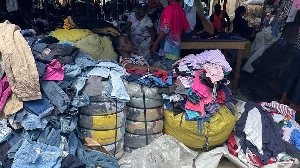Import of second-hand clothes, popularly known as ‘obroni wawu’, has reached a staggering US$323.32 million over two years – in 2021 and 2022, according to data from the Ghana Used Clothes Dealers’ Association (GUCD).
The association’s Chair, Jeffren Abrokwah, at the launch of an evaluation report on the socio-economic and environmental impact of the second-hand clothes trade in Accra, touted the sector as pivotal to the economy, employing millions of Ghanaians.
The launch of the evaluation report followed an earlier report by the OR Foundation, which claimed that 40-50 percent of second-hand clothes imported into Africa are waste, creating pollution and negative environmental impacts.
However, the GUCD’s report found that only five percent of clothing in imported bales could be considered waste, with plastics, paper, and metals recording the highest percentage of waste in the country.
The data shows that only about 2.2 percent of textile waste in Accra accounts for the overall waste generated across the capital, contrary to what the OR Foundation reported.
Indeed, the President of the Ghana Union of Traders Association (GUTA), Dr. Joseph Obeng, emphasised the important role of the used-clothes trade in Ghana. He explained that second-hand clothes offer an affordable means of clothing and provide raw materials for local manufacturers, including pillow, shopping bag and upholstery makers, among others.
On health implications, Dr. Obeng explained that no known disease or ailment has been found to be associated with wearing used clothes, as various researches have indicated. He described the report of the OR Foundation as an agenda by the West to kill the trade in Ghana and other African countries.
The Kenya example
Speaking at the same event, the Chairperson of the Kenyan Used Clothes Dealers Association, Teresia Wairimu, stated that the sector employs over two million people in the East African country and contributes approximately US$100 million in taxation revenue annually to Kenya’s economy.
She said used clothing plays important role in that country, enabling more than 24 million Kenyans, most of whom live below the poverty line, to afford sufficient clothing.
The sector in perspective
Data from GUCD confirms that the second-hand clothes industry employs approximately 2.5 million traders in Ghana and contributes almost US$30 million to the local economy each year.
The sector involves about five million Ghanaians in the value chain, from importers to upholstery makers and leather product workers, impacting the livelihoods of more than 10 million people.
There are about 5,000 stalls of second-hand clothes retailers in Accra alone, with Kantamanto, the hub of the trade, receiving about 50 40-foot containers of bales weekly.
The UK remains the highest exporter of used clothes to Ghana, bringing in US$145.5 million worth of clothes in 2021 and 2022, followed by China, which brought in US$82.4 million within the same period. The rest are from Canada, Netherlands, Poland, US, Germany, South Korea, Italy, and Belgium, in that order.
The local apparel industry
Despite the prospects in the used clothing business, AGI President Dr. Kwesi Ayim Darke told the B&FT that there is a need for a revival of the local apparel industry to resuscitate lost jobs in the sector.
As a matter of fact, local textile industry stakeholders have always expressed concern over the collapse of the country’s garment industry under the weight of cheap imports from Asia and elsewhere.
They maintain that the sector’s revival is key to job creation and industrial growth.
Business News of Thursday, 16 May 2024
Source: thebftonline.com
Second-hand clothes import hits US$323 million in two years
Entertainment












